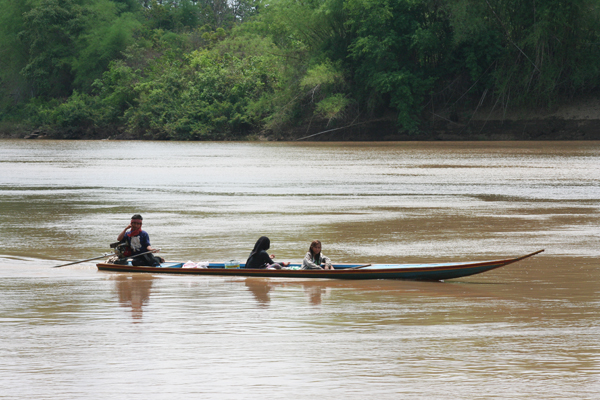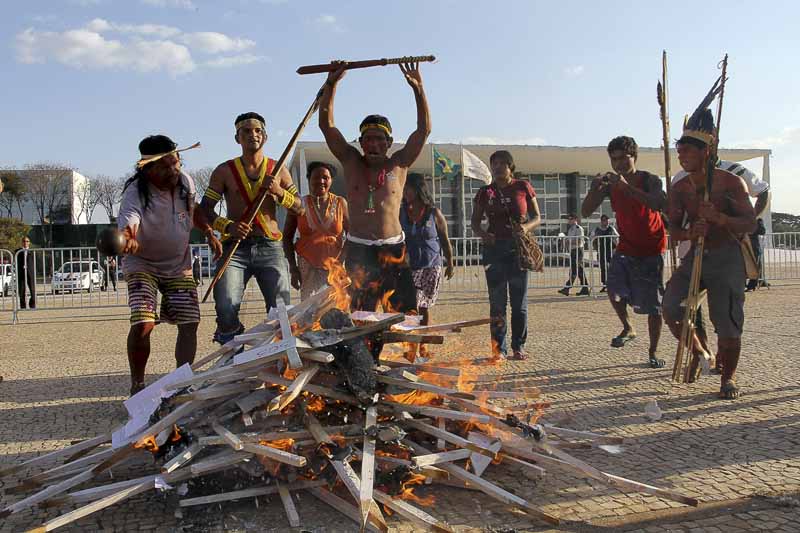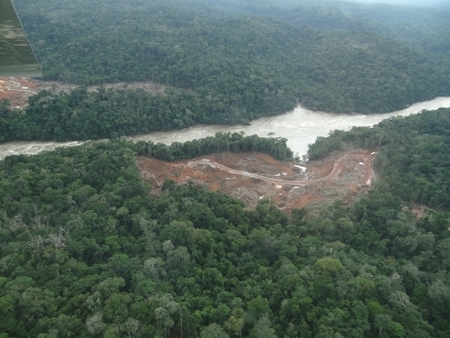
by Deep Green Resistance News Service | Nov 3, 2012 | Biodiversity & Habitat Destruction
By Agence France-Presse
Energy-hungry Cambodia on Friday gave the green light to a multi-million dollar hydropower dam backed by companies from China and Vietnam that activists say will affect thousands of people.
The Hydro Power Lower Sesan 2 project will invest $781.5 million to build a 400-megawatt hydroelectric dam on a tributary of the Mekong River in northern Stung Treng province, according to a government statement.
The government did not name the Chinese and Vietnamese firms involved, but said solutions had been reached for affected villagers.
Prime Minister Hun Sen also ordered authorities and the company to build new homes and prepare land for an unspecified number of families that would be resettled for the project, according to the statement.
Activist Meach Mean, coordinator at an environmental group 3S Rivers Protection Network, estimated more than 50,000 people would be affected by the dam.
“We are surprised by the approval,” he told AFP, calling on the government and the company to hold a public forum to discuss concerns before going ahead.
“We don’t know clearly about the process to build the project,” he said. “We are really concerned about the impact on the people’s livelihoods, water, and ecology system.”
UN human rights envoy Surya Subedi also raised concerns about the dam in a report in September, saying communities reported they had not been adequately consulted about the impact of the project.
Cambodia late last year opened the country’s largest hydropower dam to date, a more than $280 million Chinese-funded project that has attracted criticism from environmental groups.
Spiralling utility prices, driven by the lack of supply, are a major obstacle for Cambodia to attract foreign investment, and the government has struggled to find a way to bring down the cost of power.
Nine dams, including at least four funded by China, are set to open by 2019, and once they are all operational the government says they will generate 2,045 megawatts of power, serving all Cambodia’s provinces.
From PhysOrg: http://phys.org/news/2012-11-cambodia-controversial.html

by Deep Green Resistance News Service | Oct 9, 2012 | Biodiversity & Habitat Destruction, Colonialism & Conquest, Indigenous Autonomy, Obstruction & Occupation
By Jeremy Hance / Mongabay
Construction on Brazil’s megadam, Belo Monte, has been halted again as around 150 demonstrators, most of them from nearby indigenous tribes, have occupied the main construction site at Pimental. Over a hundred indigenous people joined local fishermen who had been protesting the dam for 24 days straight. Indigenous people and local fishermen say the dam will devastate the Xingu River, upending their way of life.
“The renewed occupation of the project’s earthen cofferdams paralyzed construction works, while indigenous protestors seized the keys of trucks and tractors forcing workers to leave the strategic Pimental work camp on foot,” reads a press release from the NGO Amazon Watch. Around 900 workers were sent home.
This is the second occupation attempt in less than six months. Over the summer some 300 indigenous people sustained an occupation of the dam for 21 days, before breaking it off though little headway was made in talks with consortium building the dam, Norte Energia.
The Belo Monte dam, which would be the world’s third largest, has been plagued by controversy from its origin decades ago; the battle for the dam has been fought both in Brazil’s courts and on the international stage. If built, the dam will flood an estimated 40,000 hectares of present rainforest and could push some fish species to extinction. In addition, 16,000 people will be displaced according to the government, though some NGOs say the number is more likely double that.
Despite the impacts, the dam has been strongly supported by Brazilian President Dilma Rousseff, and every legal injunction against the dam has been overturned. Norte Energia has filed with a local court for repossession of the construction sties.
Indigenous groups say the construction of the dam is already imperiling their way of life, as the Xingu river becomes more difficult to navigate. They have also said they have no intention of leaving until Norte Energia meets their demands.
“We are witnessing the devastation of this land. The island of Pimental was completely destroyed, with a sole tree left standing, and the water is putrid. It is very shocking,” an protestor told Amazon Watch.
Dams are often described as ‘green’ energy source, however in the tropics they actually release significant methane emissions due to rotting vegetation. Although it has a shorter life than carbon, methane is a far more potent greenhouse gas.
From Mongabay: “Indigenous groups re-occupy Belo Monte dam in the Amazon“
by Deep Green Resistance News Service | Oct 1, 2012 | Colonialism & Conquest, Indigenous Autonomy, Obstruction & Occupation
By Mongabay
200 indigenous men and women are blockading shipments of construction materials to a dam site in Malaysian Borneo to protest the impact of the hydroelectric project on their traditional forest home, reports the Bruno Manser Fund (BMF), a Switzerland-based group that campaigns on behalf of forest people of Sarawak.
According to the NGO, on the morning of September 26, 200 Penan and Kenyah set up a blockade on the road used by trucks to deliver supplies to Murum dam, a controversial project being built by China’s Three Gorges Corporation. The protesters say they will maintain the road block until Sarawak Energy, the agency behind the dam, meets with them and agrees to their demands relating to involuntary resettlement and their traditional land rights. The dam would flood up to 250 square kilometers of rainforest and farmland, affecting some 1,400 people, says BMF, which adds that the communities fear a repeat of the nearby Bakun dam.
“They have witnessed how the quality of life decreased for their neighboring communities affected by Bakun dam, one of the biggest dams in Asia, when they were forcefully displaced in 1998,” BMF said in a statement. “They do not want to face the same fate: loss of livelihood, poverty and loss of culture.”
The government of Sarawak is planning to build at least a dozen dams over the next twenty years, well exceeding the state’s demand for electricity. But Sarawak says it aims to attract energy-intensive industries like mining. Critics argue that the primary motivation is corruption: large infrastructure offer big opportunities for officials to line their pockets using state funds. Sarawak’s Chief Minister Abdul Taib Mahmud is accused of amassing a personal fortune of some $15 billion through such approaches as well as control over the state’s forest resources.

by Deep Green Resistance News Service | Aug 26, 2012 | Biodiversity & Habitat Destruction, Colonialism & Conquest, Indigenous Autonomy, Lobbying
By Fabiola Ortiz / Inter Press Service
The Sete Quedas or “seven waterfalls” on the Teles Pires River, which runs through the Amazon rainforest states of Mato Grosso and Pará in central Brazil, are a spiritual oasis venerated by several indigenous groups.
But the 20-metre-high rocky falls are to be covered by a reservoir created by a hydroelectric dam that is to flood an area of 95 square km.
“It’s a sacred area, our creator and mother. And the ‘pajé’ (shaman) says it is where the fish lay their eggs,” João Kayabi, 52, told IPS by phone from the area. He is the chief of Kururuzinho village, home to 106 members of the Kayabi community, who speak a Tupí-Guaraní language.
For the Kayabi, the area around Sete Quedas must be left untouched, because it is the dwelling of a god who is responsible for the natural balance.
“It will be left underwater, and will only be a memory. We are trying to keep that from happening,” Kayabi said.
Sete Quedas is also sacred to two other indigenous communities: the Apiaká and the Mundurukú. For the latter, the falls are “the mother of fish” and the dwelling-place of their ancestors.
“The Mundurukú say the river is going to dry up, there will be a shortage of food, and the fish will vanish. I hope that isn’t so,” Kayabi said.
Studies on the biodiversity in that stretch of the river, carried out by Brazil’s Energy Research Company (EPE), which conducts research for the Ministry of Mines and Energy, have identified nearly 700 plant species and more than 200 species of fish, such as the spotted sorubim (Pseudoplatystoma corruscans) catfish, the common dolphinfish (Coryphaena hippurus), and the jau (Zungaro zungaro) catfish.
The Teles Pires has the reputation of being one of the world’s best rivers for fishing.
In the indigenous territory where João Kayabi’s village is located, nearly 300 people make a living from hunting, fishing and harvesting fruit.
“Up to now, our land has provided for us sufficiently. But we are concerned about what will happen in the future, and whether food will be scarce,” said the chief, a father of seven. “I’m worried about my children; I don’t know what will become of their lives.”
The Teles Pires plant will have a generating capacity of 1,820 MW. But the Companhia Hidrelétrica Teles Pires, the company that was granted the concession for building the dam, is fighting a judicial battle to be able to finish construction.
The project collides with the beliefs, customs and traditions of the Kayabi, Mundurukú and Apiaká Indians (a combined total of 12,000 people), said indigenous rights lawyer Juliana de Paula Batista, who advises native organisations in Brazil’s southwest Amazon region.
The case has been winding its way through the courts. In early August, a regional federal court ordered suspension of construction of the dam. But the attorney general’s office and Brazil’s environmental protection agency IBAMA appealed, and the suspension was lifted on Aug. 14.
“The natural resources that are indispensable for indigenous people to sustain their lifestyle and culture are being plundered,” Batista told IPS.
Early this year, the office of the public prosecutor brought a civil lawsuit to revoke the environmental license granted by IBAMA in August 2011 and bring construction to an immediate halt.
According to Batista, the environmental licensing process is flawed. “At no time has the magnitude of the impact on indigenous lands been fully understood.”
“The dam endangers fish stocks, the sacred site, water quality, rare and endemic species, vegetation in general, and hunting,” the lawyer said.
Although the tribes will not have to be relocated, they are afraid to remain in their villages “because in case of accidents, such as a break in the dam, the water would carry them away,” Batista said.
The Kayabi villages are only 50 km from the dam.
“There is no solution when it’s a government plan, we have no way to fight this,” Kayabi said. “The only way is to seek support and guidance. The dam will be built, and we are the ones who will be hurt by it, we could lose our rights.”
One of the irregularities noted by the office of the public prosecutor was the company’s failure to consult with the affected indigenous communities prior to the start of construction, as required by law. In March, work on the dam had already been suspended in response to the prosecutors’ request.
Read more from Inter Press Service: http://www.ipsnews.net/2012/08/hydropower-dam-to-flood-sacred-amazon-indigenous-site/



